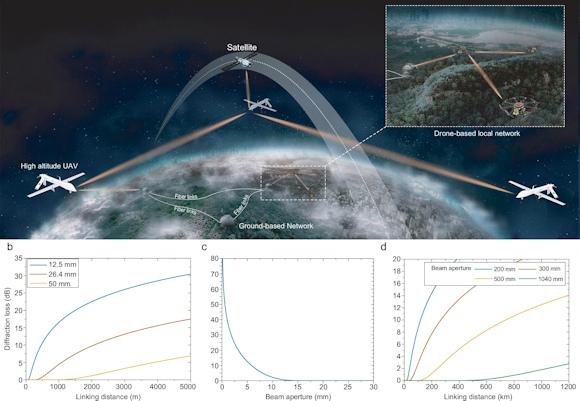Chinese scientists say they have developed, first in the world, a fleet of drones for the "secure" transmission of information with quantum communication technology.
The work, published last January in the magazine National Science Review1, it is thanks to researchers from the University of Nanjing, in eastern China, who would have developed - as reported by the South China Morning Post2 of Hong Kong -, unmanned aircraft capable of autonomously generating pairs of entangled light particles, capable of "carrying information".
L'entanglement3, in quantum physics, is the mechanism by which, between two interacting particles, a bond is created that remains active even when they are removed, so that, when one of the two assumes a different state, this is replicated to theinstantand on the other.
How do you explain4 the University of Padua, among the world's largest research centers in the field: "Quantum communications offer an encryption system that is impossible to violate, based on the exchange of" quantum bit "(or qubit), the quantum version of the classic bit. While the classic bit can only take two distinct values, 0 or 1, the qubit can be found in one "overlap" quantum between the two states | 0> and | 1>. The QKD (or quantum key distribution) then allows you to create a shared and secure encryption key between two users (..).
Safety is therefore guaranteed by the laws of quantum mechanics, which ensure that no other user can get information about the key.
These laws ensure that there is no "quantum photocopier" (a qubit cannot be copied) and that any measurement on the qubit alters its status.
The quantum properties therefore allow the secure transmission of "secret" information, since any attempt to intercept its content would imply, regardless of the distance, an alteration of the bond existing between the particles with which the content was associated, altering its message and, above all, notifying the sender and recipient of the attempted violation.
The researchers of National Laboratory of Solid State Microstructures5 for this purpose they created quantum communication devices of very small dimensions that can be mounted on drones, weighing 35 kg (10 of them were produced).
The next step will be to achieve absolute security in data transmission, through a network of drones (which each generate 2,4 million pairs of "entangled" particles of light per second) capable of connecting with quantum satellites, the first of which, called "Mozi", was sent into orbit6 in August 2016.
Thus putting an end, definitively, to the mathematical cryptography to which today the security of encrypted communications is entrusted globally, destined to become obsolete and violable with the introduction of quantum computers, such as that created by Google7, able to perform in 200 seconds operations that today would require the fastest computer in the world8 10.000 years.
In any case, quantum communication technology involves much more work to solve some objective difficulties, such as, for example, what still appears to be a necessary condition for the successful end of the transmission, i.e. that the receiver and the sender are among them positioned in a straight line.
China remains the undisputed global leader in quantum communication technology to date. In addition to the only (in the world) quantum satellite currently in orbit, Beijing has the longest and most complex terrestrial quantum communication network on the planet between Beijing and Shanghai.
Recently, the Chinese have built a mobile earth station9 weighing 80 kg, of a size that allows it to be transported in a car, capable of connecting with the satellite Cinema and from this receive cryptographic keys in the form of entangled light particles (the ground station active at the launch of Cinema instead weighed 10 tons).
The new mobile station transmits data at a speed between 4000 and 10.000 bits per second, compared to about 40.000 bits per second of the larger stations, but the possibility of varying the location at will, to facilitate transmission with the satellite, largely compensates the transmission limitation.
In addition to being inspired by national security reasons, Chinese development in the field of quantum transmissions is also driven by the commercial sector.
La Industrial and Commercial Bank of China (ICBC) and the People's Bank of China already use quantum technology among the branches scattered throughout the country. To meet the growing needs of the private sector, it is already planned to launch a fleet of dedicated nano satellites in the short term.
8https://en.wikipedia.org/wiki/Summit_(Supercomputer)
9https://www.scmp.com/news/china/science/article/3044385/chinese-scientis...
Image: National Science Review












